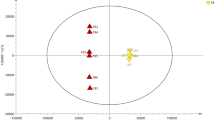Abstract
Objective
To study the biotransformation of phytosterol and phytosterol-containing rice germ and wheat germ ethanolic extracts to produce 4-androstene-3,17-dione (AD) and 1,4-androstadiene-3,17-dione (ADD) by Mycobacterium sp. DSM 2966 using phytosterol to hydroxypropyl-β-cyclodextrin (2:1, 1:1 and 1:2 mol/mol) and 2 % (w/v) Tween 80 as solubilizing agents.
Results
A maximum yield of 180 ± 27 mg AD l−1 and 31 ± 11.4 mg ADD l−1 with a total conversion of 65 % (day 12) was obtained using 1 g phytosterol l−1 and hydroxypropyl-β-cyclodextrin (2 : 1 mol/mol) with 2 % (w/v) Tween 80 in the fermentation medium. The most appropriate conditions for rice germ extract and wheat germ extract which gave the maximum conversion of 22 and 43 % (day 14) were obtained by using 2 % (w/v) Tween 80.
Conclusions
Phytosterol and wheat germ are effective sources for AD and ADD production while rice germ required further development. Hydroxypropyl-β-cyclodextrin (2 :1 mol/mol) and/or 2 % (w/v) Tween 80 in the biotransformation process could improve AD and ADD yields, depending on substrates and biotransformation conditions.




Similar content being viewed by others
References
Abd-elsalam I, Salam LA, Abd-Elhady A (2010) Optimization of sugar cane phytosterols bioconversion using Arthrobacter rubellus. J Appl Sci Res 6:1334–1339
Aleem O, Kuchekar B, Pore Y, Late S (2008) Effect of β-cyclodextrin and hydroxypropyl-β-cyclodextrin complexation on physicochemical properties and antimicrobial activity of cefdinir. J Pharm Biomed Anal 47:535–540
Bhatnagar AS, Prabhakar DS, Kumar P, Rajan R, Krishna A (2014) Processing of commercial rice bran for the production of fat and nutraceutical rich rice brokens, rice germ and pure bran. LWT Food Sci Technol 58:306–311
Bureik M, Bernhardt R (2007) Steroid hydroxylation: microbial steroid biotransformations using cytochrome P450 enzymes. In: Schmid RD, Urlacher VB (eds) Modern biooxidation: enzymes, reactions and applications. Wiley, Weinheim, pp 155–176
Carvalho F, Maques MPC, de Carvalho CCCR et al (2009) Sitosterol bioconversion with resting cells in liquid polymer-based system. Bioresour Technol 100:4050–4053
Chowdary KPR, Srinivasan S (2011) Effects of cyclodextrins, Tween-80 and PVP on the solubility and dissolution rate of etoricoxib. J Pharm Sci Res 3:1344–1348
Donova MV (2007) Transformation of steroids by actinobacteria: a review. Appl Biochem Microbiol 43:1–14
Donova MV, Egorova OV (2012) Microbial steroid transformations: current state and prospects. Appl Microbiol Biotechnol 94:1423–1447
Gyüre I, Lenkey B, Szentirmai A (1993) Propionyl-CoA elimination may be a rate-determining step of selective cleavage of sterol side chain. Biotechnol Lett 15:925–930
Kwon Y, Lee K, Yun T, Choi S (2004) Effect of heat pretreatment on the functional constituents of rice germ. Prev Nutr Food Sci 9:330–335
Lin Y, Song X, Fu J, Lin J, Qu Y (2009) Microbial transformation of phytosterol in corn flour and soybean flour to 4-androstene-3,17-dione by Fusarium moniliforme Sheld. Bioresour Technol 100:1864–1867
Mahmoud AA, Mohdaly AAA, Elneairy NAA (2015) Wheat germ: an overview on nutritional value, antioxidant potential and antibacterial characteristics. Food Nutr Sci 6:256–277
Malaviya A, Gomes J (2008) Androstenedione production by biotransformation of phytosterols. Bioresour Technol 99:6725–6737
Manosroi A, Saowakhon S, Manosroi J (2008) Enhancement of androstadienedione production from progesterone by biotransformation using the hydroxypropyl-β-cyclodextrin complexation technique. J Steroid Biochem Mol Biol 108:132–136
Perez C, Falero A, Llanes N, Hung BR, Harve ME, Pamero A, Marti E (2003) Resistance to androstanes as an approach for androstenedienedione yield enhancement in industrial mycobacteria. J Ind Microbiol Biotechnol 30:623–626
Plumb JA, Rhodes M, Lampi A, Buchgraber M, Kroon P (2011) Phytosterols in plant foods: exploring contents, data distribution and aggregated values using an online bioactive database. J Food Compos Anal 24:1024–1031
Roglic U, Znidarsic-Plazl I (2005) The influence of β-cyclodextrin on the kinetics of progesterone transformation by Rhizopus nigricans. Biocatal Biotransform 23:299–305
Saab HB, Fouchard S, Boulanger A, Llopiz P, Neunlist S (2013) Luffa cylindrica and phytosterols bioconversion: from shake flask to jar bioreactor. J Ind Microbiol Biotechnol 40:1315–1320
Schmid A, Dordick J, Kiener A, Wubbolts M, Witholt B (2001) Industrial biocatalysis today and tomorrow. Nature 409:258–268
Shen Y, Wang M, Zhang L, Ma Y, Ma B, Zheng Y, Liu H, Luo J (2011) Effects of hydroxypropyl-β-cyclodextrin on cell growth, activity, and integrity of steroid-transforming Arthrobacter simplex and Mycobacterium sp. Appl Microbiol Biotechnol 90:1995–2003
Sripalakit P, Wichai U, Saraphanchotiwitthaya A (2006) Biotransformation of various natural sterols to androstenones by Mycobacterium sp. and some steroid-converting microbial strains. J Mol Catal B 41:49–54
Wadhwa L, Smith KE (2000) Progesterone side chain cleavage by Bacillus sphaericus. FEMS Microbiol Lett 192:179–183
Wang W, Yu L (2011) Preparation, characterization, and biotransformation of the inclusion complex of phytosterols and hydroxypropyl-β-cyclodextrin by Mycobacterium neoaurum. Zeitschrift für Naturforschung C 66:277–282
Wang Z, Zhao F, Chen D, Li D (2005) Cloud point system as a tool to improve the efficiency of biotransformation. Enzyme Microb Technol 36:589–594
Wei W, Fan SY, Wang FQ, Wei DZ (2010) A new steroid-transformation strain of Mycobacterium neoaurum and cloning of 3-ketosteroid 9α-hydroxylase in NwIB-01. Appl Biochem Biotechnol 162:1446–1456
Westfechtel A, Behler A (2006) Ethercarboxylic acid ester of sterol or stanol. US Patent 20060183723
Zhang XY, Peng Y, He G (2012) Improved water-solubility of phytosterol by hydroxypropyl-β-cyclodextrin. Adv Mater Res 554–556:922–925
Zhang XY, Peng Y, Su ZR, Chen QH, Ruan H, He GQ (2013) Optimization of biotransformation from phytosterol to androstenedione by a mutant Mycobacterium neoaurum ZJUVN-08. J Zhejiang Univ Sci B 14:132–143
Acknowledgments
This work was financially supported by Research Funds from Yearly Budget, Naresuan University (Grant No. R2558B033), Phitsanulok, Thailand.
Author information
Authors and Affiliations
Corresponding author
Rights and permissions
About this article
Cite this article
Saraphanchotiwitthaya, ., Sripalakit, P. Production of 4-androstene-3,17-dione and 1,4-androstadiene-3,17-dione from rice germ and wheat germ extracts by Mycobacterium sp.. Biotechnol Lett 38, 1595–1602 (2016). https://doi.org/10.1007/s10529-016-2140-1
Received:
Accepted:
Published:
Issue Date:
DOI: https://doi.org/10.1007/s10529-016-2140-1




